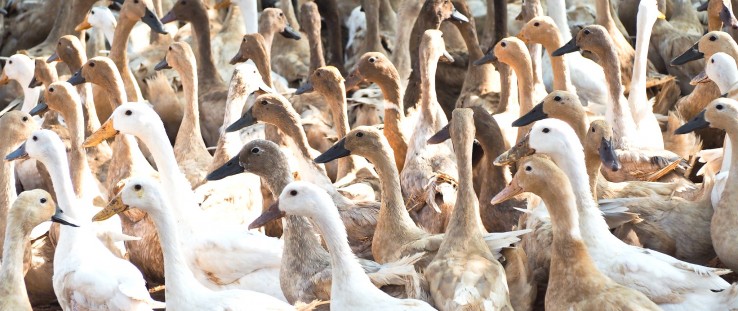 Ducks at Vo Duy Ich’s poultry farm keep to themselves.
Richard Nyberg, USAID
Ducks at Vo Duy Ich’s poultry farm keep to themselves.
Richard Nyberg, USAID
 Ducks at Vo Duy Ich’s poultry farm keep to themselves.
Richard Nyberg, USAID
Ducks at Vo Duy Ich’s poultry farm keep to themselves.
Richard Nyberg, USAID
VIENTIANE, Laos—All is calm and pleasant under the early morning sun on Vo Duy Ich’s poultry farm, nestled between a pond and a rice field on the outskirts of Laos’ capital, Vientiane. The tranquility is suddenly shattered by raucous squawking and flapping, however, when the experienced farmer hops into a makeshift enclosure and lunges with mask and gloves at a duck that desperately tries to scramble behind some feathered friends.
Stepping out of the blue plastic pen, Ich stretches out his prized bird toward a rubber-booted vet, who plunges a needle into the top of the duck’s head to draw blood. Putting that sample safely aside, he digs in his bag for two long swabs and probes each end of the duck—yet more samples for the lab technicians to examine. The farmer from Vietnam’s bordering Nghe An province and his visiting veterinarian sample four other ducks in the same way before letting the birds scurry back to the flock.
Ich, a 51-year-old father of three grown children, knows the drill. He welcomes regular visits by animal health teams trained and supported with USAID funding, and sprays disinfectant around his farm. So far, he has been lucky: Provincial vets conducting routine surveillance have yet to detect a virus here, but they remain vigilant. With reason.
Ich shares his home with 1,500 ducks which, when young enough, lay 1,200 eggs a day—eggs he puts into his homemade incubator to grow his business in boiled embryonic eggs, a local delicacy.
“I make more money that way,” he chuckled, explaining his market niche.
The ducks waddling around the farm these days are nearly 2 years old, and laying only about 800 eggs a day. He will soon slaughter them to be sold as meat, and start all over again.
A poultry farmer for 14 years, Ich, like the birds of Southeast Asia, moves around often, setting up his operation in a new place every five years where he believes his business can flourish.
In many ways, Ich lives and works at the shifting crossroads of infectious disease response in Southeast Asia that, by extension, helps prevent the rest of the world from outbreaks. With Laos—officially known as Lao People’s Democratic Republic (PDR)—sandwiched between Burma, Cambodia, China and Thailand, Ich tends to his flock in a region with high livestock mobility and high demand for poultry, especially during the Lunar New Year celebrations.
The surveillance at Ich’s farm is the first line of defense against the highly pathogenic and historically devastating avian influenza, H5N1, and a range of other zoonotic viruses—those transmissible from animals to humans—such as H5N6 and H7N9. The stakes are high when it comes to people, poultry and pandemics.
Disease Detectives
According to the United Nations’ Food and Agriculture Organization (FAO), H5N1 killed or forced authorities to cull over 400 million domestic poultry and caused an estimated $20 billion in economic losses worldwide before it was eliminated from most of the 63 countries that were infected.
As of Jan. 6, and dating back to 2003, the World Health Organization (WHO) had received reports of 694 laboratory-confirmed human cases of highly virulent avian influenza H5N1 from 16 countries. Of these, 402 people died. Although largely in check, the virus is still endemic in Bangladesh, China, Egypt, Indonesia and Vietnam, and, as is common with highly volatile influenza viruses, is always evolving. China’s Ministry of Agriculture estimated the economic impact from H7N9 alone by mid-2013, three months after an outbreak, at $6.5 billion; close to 500 people have been infected by the virus.
USAID and its partners, including FAO and WHO, have been at the forefront of responding to avian influenza and other emerging pandemic threats. Since 2006, USAID has funded activities to help 20 countries around the world—many in South and Southeast Asia—better control outbreaks with field detection, field sampling and laboratory analysis.
“At this point, we can see that the countries have good capacity in accurate detection of influenza,” said Dr. Wantanee Kalpravkdh, regional manager of FAO’s Emergency Center for Transboundary Animal Diseases.
Among the tools now in use in a network of 20 national labs across South and Southeast Asia are polymerase chain reaction machines that take small fragments of genetic material and make a billion copies so they can be more easily detected. It also leads to more accurate diagnosis and cuts the time to run detection tests by hours, while doing a better job keeping technicians safe. The machines are running daily at the Lao National Animal Health Laboratory in Vientiane, and helped staff in March 2014—during the country’s last outbreak—to detect the H5N6 strain.
“Our laboratory has played a great role in supporting the data and findings from surveillance conducted in three northern provinces in Laos that share a border with China,” said Dr. Bounlom Douangngeun, director of the National Animal Health Laboratory at the Lao PDR Ministry of Agriculture and Forestry Department of Livestock and Fisheries.
The sample in question was collected and sent to the laboratory for testing. Lab staff identified H5 and sent the sample on for further testing at the reference lab in Australia, where they discovered N6. Hundreds of birds were then culled at two locations from a poultry importer after animal and human health experts visited the region. The incident was hailed internationally as a best practice of how officials, in this case, those trained by FAO and other partners with USAID support, should respond.
Using this and other technology, national experts have learned a great deal more on how to manage these threats, and are thinking ahead.
“Most of the countries have contingency plans that function as operational manuals for outbreak response,” said FAO’s Kalpravkdh. “So they have the knowledge, they have the plan documented, and the possibility to conduct this field outbreak containment is already there.”
But that’s just one disease to track. Unfortunately, there are many more out there.
Beyond Bird Flu
These zoonotic influenzas are one example of a broader set of emerging zoonoses capable of sparking a future pandemic, and which often circulate silently in wildlife such as bats, rodents and primates. As people move closer into the forest to live, farm and hunt, they also face greater exposure to these diseases.
Studies show that nearly 75 percent of all new, emerging or re-emerging zoonotic diseases originate in wildlife. The spread of these diseases poses a global threat and presents serious public health, economic and development concerns. The list includes AIDS, SARS, MERS, Ebola and Nipah—the disease portrayed in the 2011 movie Contagion, which spread from bats to pigs to humans.
Since 2009, USAID has intensified its work to prevent outbreaks and respond rapidly if they do occur in 20 countries considered hotspots for zoonotic diseases. USAID partners have taken tens of thousands of samples in Laos and other countries to test for pathogens. They also studied behavioral patterns about how communities are interacting with wildlife and have documented a high level of wildlife consumption that presents substantial risk to those who do the slaughtering, selling, cooking or eating of the animals.
“Test results will be useful for the people or any organizations interested in raising public awareness because the Lao people have their own traditional habit of eating the wildlife,” said Bounlom. “We should try to make them understand the risk of contact with wildlife by providing the right information.”
Asia is an important area for focus on infectious diseases, as domestic livestock and trafficked wildlife can run along the same corridors across countries in South and Southeast Asia.
“Evidence suggests Asia remains a hotspot for emergence, as agricultural intensification and land use change are hurtling humans, livestock and wildlife into unprecedented levels of contact,” said Dr. Daniel Schar, USAID’s Asia regional emerging infectious diseases adviser. “The work we are doing across Asia is strengthening critical front line capacity to rapidly detect and respond to emerging diseases.”
One Way Forward—One Health
Increasingly, experts acknowledge that the best way to build fences around infectious diseases at the source is to build bridges between animal and human health professionals within governments in South and Southeast Asia under an approach known as “One Health.”
Already, several countries have set up coordinating offices, including in Laos, where the prime minister chairs the National Committee for the Control of Communicable Diseases. The Association of Southeast Asian Nations (ASEAN) has endorsed a plan to set up an ASEAN Coordination Center for Animal Health and Zoonoses, and a formal agreement is expected to be signed by ASEAN member states in 2015. With this, the member countries agree to maintain an animal health policy and coordinate well; each nation would need to allocate funds to keep the center sustainable.
The timing is key, as the forthcoming ASEAN Economic Community plans to increase agricultural trade, including livestock, among ASEAN member countries. Similarly, the South Asia Chief Veterinary Officer Group is working on a regional strategy to control disease outbreaks.
“An integrated human-animal health approach is the most effective way to reduce risk, detect and control zoonotic diseases,” said Richard Brown, program officer for border health at WHO Thailand.
In Thailand, USAID provided funding for animal, human and wildlife health officials to implement a One Health approach at the provincial level and a pilot at the district level. They meet every two or three months to share information and discuss health issues like rabies and Ebola, and conduct joint active surveillance and outbreak investigations. After the one-year project ended in December 2014 and engaged 10 provinces, the government is extending the approach to an additional five provinces.
“You cannot stand alone,” Preecha Wongwicharn, director of Thailand’s National Institute of Animal Health, said about the merits of a One Health approach. “You have to cooperate with other countries because you cannot control only the disease in your country. Even if you do well in your own country, then the neighboring country can transmit it to you, so we have to work together.”
This is where USAID steps in with regional programs that bring animal and human health experts together with the best science and technology available to stop viruses in their tracks. The U.S. Government is working together with 30 partner countries under the U.S. Global Health Security Agenda to respond to infectious disease threats. USAID’s programs provide important support to it by actively engaging with governments and international experts throughout South and Southeast Asia, Africa and the Middle East.
Ebola in West Africa and other diseases in recent years illustrate the importance of preventing, detecting and controlling disease threats where they emerge to minimize public health impact and social and economic instability in countries around the world, including the United States.
“We need smart partnerships to identify and stop diseases locally, and engage regionally across borders, before small-scale outbreaks become global crises,” said Michael Yates, director of the USAID Regional Development Mission for Asia.
For Asia’s disease crossroads countries like Laos and for farmers like Ich and their families—who stand to lose their livelihoods through culling and run the risk of infection during disease outbreaks—being vigilant means being ready for the unseen and unannounced.
“Because we are [surrounded by] different countries, we identify ourselves at risk because of the movement of animals and people,” said Dr. Bounlay Phommasack, director general of the Department of Disease Control of the Lao PDR Ministry of Health and director of the National Emerging Infectious Disease Coordinating Office. “We don’t know exactly when the virus will come.”







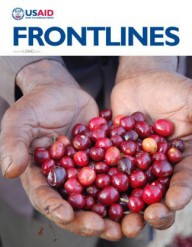

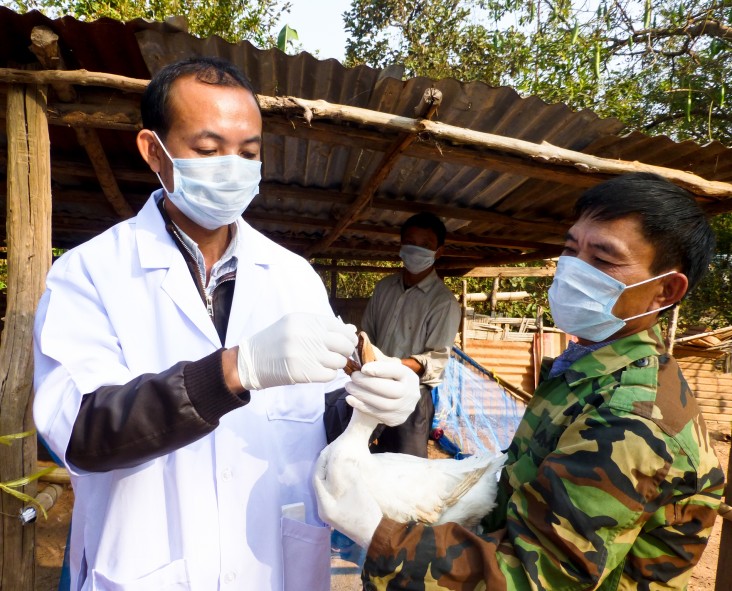
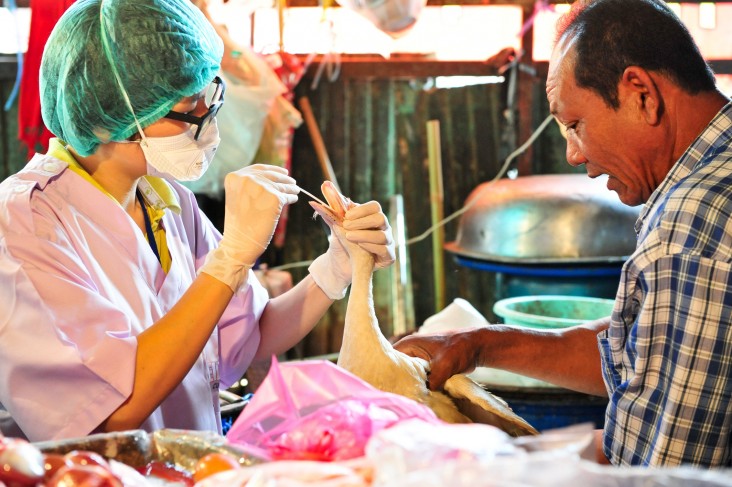
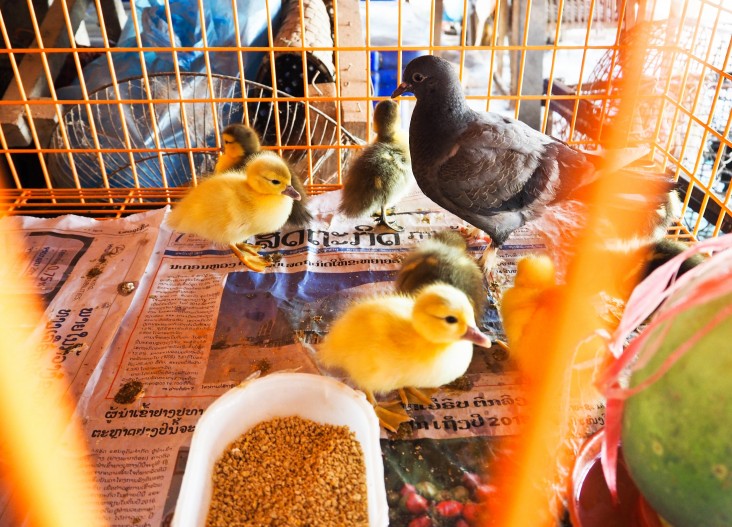
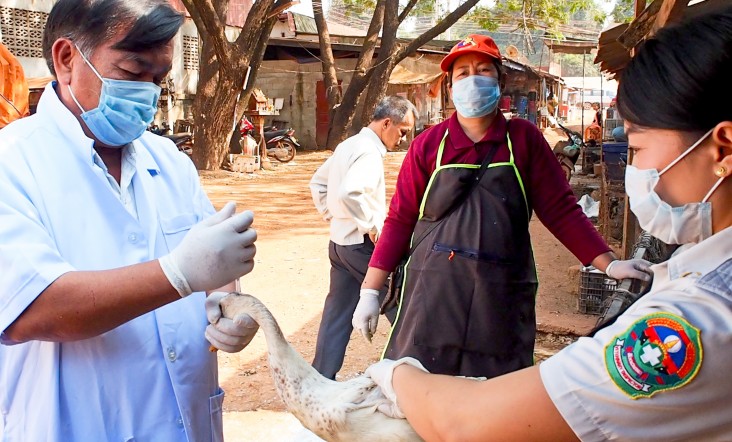
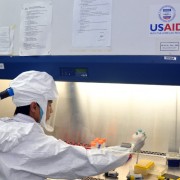
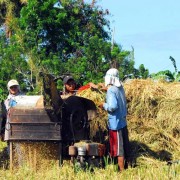

Comment
Make a general inquiry or suggest an improvement.